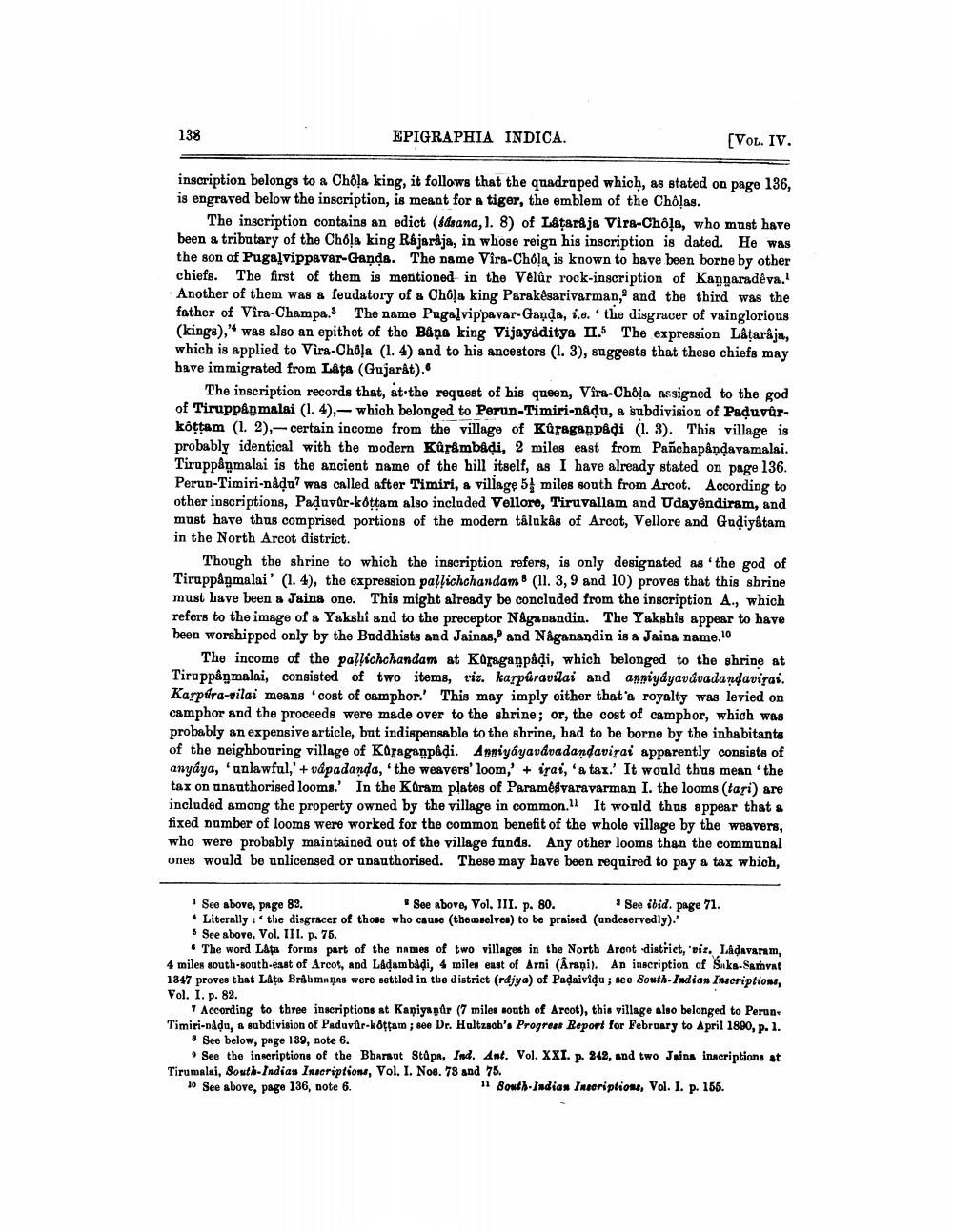________________
138
EPIGRAPHIA INDICA.
VOL. IV.
inscription belongs to a Chôļa king, it follows that the quadruped which, as stated on page 136, is engraved below the inscription, is meant for a tiger, the emblem of the Cholas.
The inscription contains an edict (fdsana, l. 8) of Lataraja Vira-Chôļa, who must have been & tributary of the Chola king Rajaraja, in whose reign his inscription is dated. He was the son of Pugalvippavar-Ganda. The name Virs-Chola is known to have been borne by other chiefs. The first of them is mentioned in the Velûr rock-inscription of Kanparadeva.! Another of them was & feudatory of a Chola king Parakêsarivarman, and the third was the father of Vira-Champa. The name Pagalvippavar-Ganda, 1.c. the disgracer of vainglorious (kings)," was also an epithet of the Båņa king Vijayaditya II. The expression Låtaraja, which is applied to Vira-Chola (1. 4) and to his ancestors (1.3), suggests that these chiefs may have immigrated from Laţa (Gujarat).
The inscription records that, at the request of his queen, Vira-Chola assigned to the god of Tiruppanmalai (1.4), which belonged to Perun-Timiri-nadu, a subdivision of Paduvurkottam (1. 2), certain income from the village of Kuragappadi (1. 3). This village is probably identical with the modern Kûrâmbâdi, 2 miles east from Panchapaņdavamalai, Tiruppåşmalai is the ancient name of the hill itself, as I have already stated on page 136. Perud-Timiri-nádu7 was called after Timiri, a village 5 miles south from Arcot. According to other inscriptions, Padurar-kottam also included Vellore, Tiruvallam and Udayêndiram, and must have thus comprised portions of the modern tâlukâs of Arcot, Vellore and Gudiyatam in the North Arcot district.
Though the shrine to which the inscription refers, is only designated as the god of Tiruppågmalai' (1.4), the expression palsichchandam (11. 3, 9 and 10) proves that this shrine must have been a Jains one. This might already be concluded from the inscription A., which refers to the image of a Yakshi and to the preceptor Någanandin. The Yakshis appear to have been worshipped only by the Buddhists and Jainas, and Naganandin is a Jaina name.10
The income of the passichchandam at Kagagaņpadi, which belonged to the shrine at Tiruppågmalai, consisted of two items, riz. karpúravilai and anniyayavavadandavirai. Karpera-vilai means "cost of camphor.' This may imply either that'a royalty was levied on camphor and the proceeds were made over to the shrine; or, the cost of camphor, which was probably an expensive article, but indispensable to the shrine, had to be borne by the inhabitants of the neighbouring village of Kosagappâți. Anniyayarávadandavirai apparently consists of anyaya, 'unlawful,' + vdpadanda, 'the weavers' loom,' + irai, 'a taz.' It would thus mean the tax on unauthorised looms. In the Karam plates of Paramégvaravarman I. the looms (tari) are included among the property owned by the village in common. 11 It would thus appear that a fixed number of looms were worked for the common benefit of the whole village by the weavers, who were probably maintained out of the village funds. Any other looms than the communal ones would be unlicensed or unauthorised. These may have been required to pay a tax which,
See above, page 82.
See above, Vol. III. p. 80.
* See ibid. page 71. • Literally the disgracer of those who cause (themselves) to be praised (undeservedly).
See above, Vol. III. p. 75.
• The word Lata forms part of the names of two villages in the North Arent district, 'sit. Ladavaram, 4 miles south-south-east of Arcot, and Ladambadi, 4 miles east of Arni (Arapi). An inscription of Suks.Samvat 1347 proves that Lata Bråbmans were settled in the district (rdjya) of Padaividu; see South Indian Inscription, Vol. I. p. 82.
1 According to three inscriptions at kaniyanur (7 miles south of Arcot), this village also belonged to Peran: Timiri-nadu, & subdivision of Padavar-kottam ; see Dr. Holtzsch'. Progress Report for February to April 1890, p. 1.
. See below, page 189, note 6.
See the inscriptions of the Bharat Stapa, Ind. Ant. Vol. XXI. p. 942, and two Jaina inscriptions at Tirumalai, South Indian Inscriptions, Vol. I. Nos. 73 and 75. • See above, page 136, note 6.
11 South Indian Inscriptions, Vol. I. p. 155.




